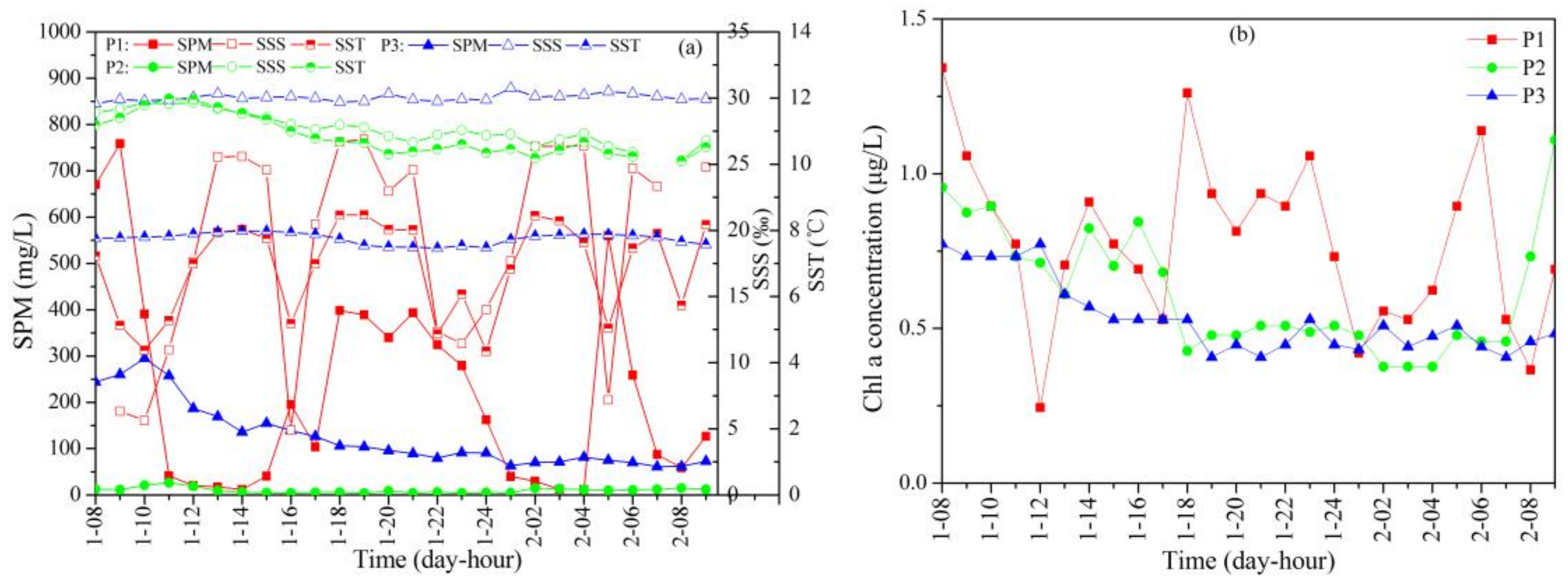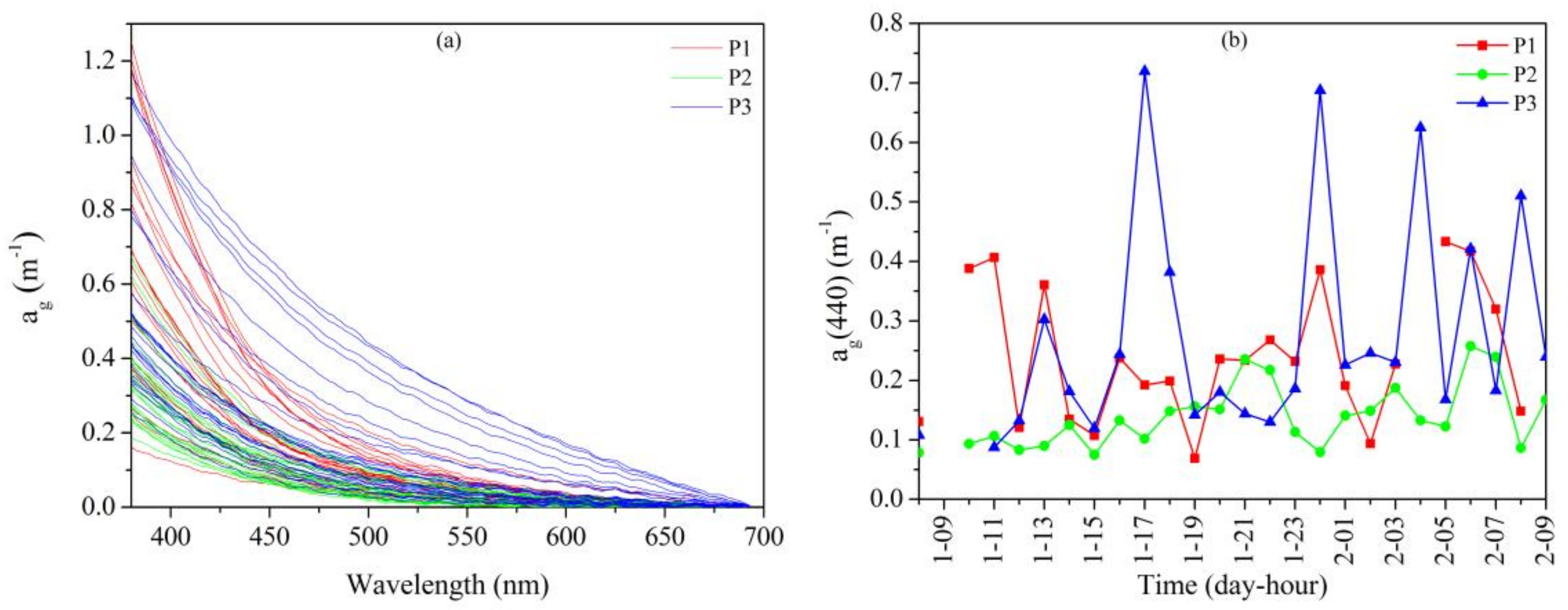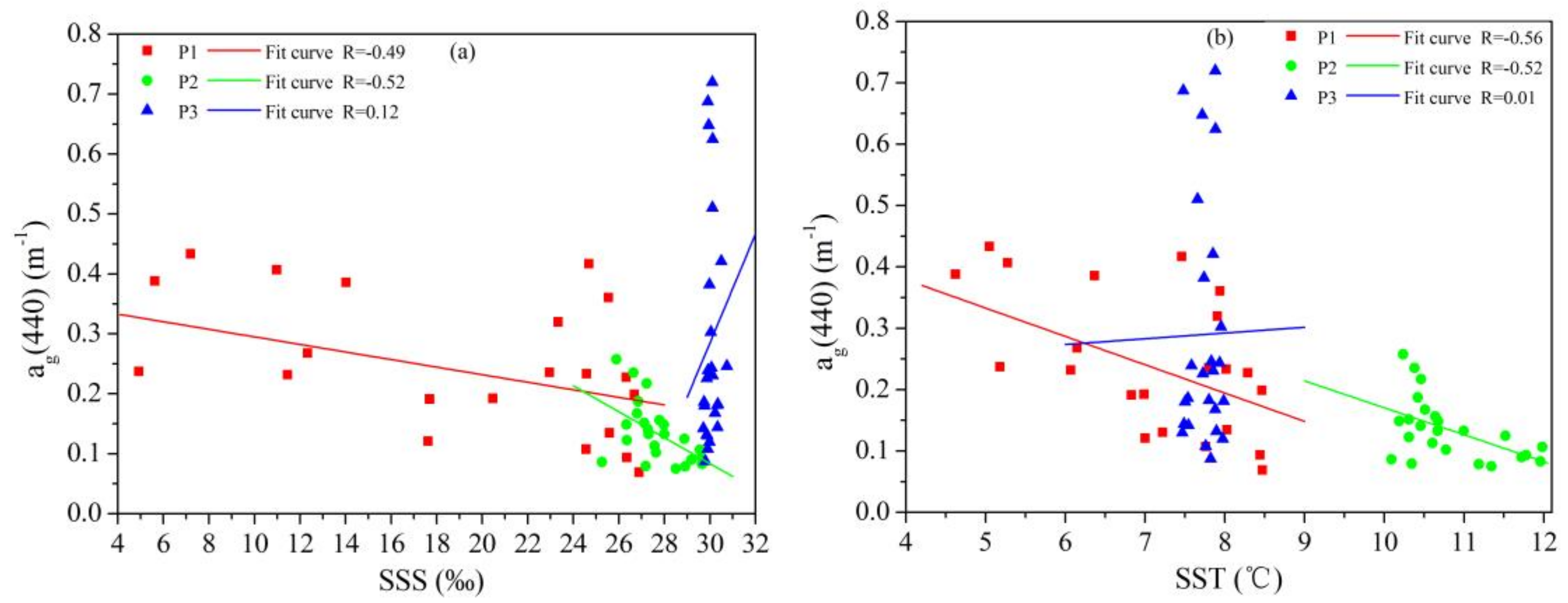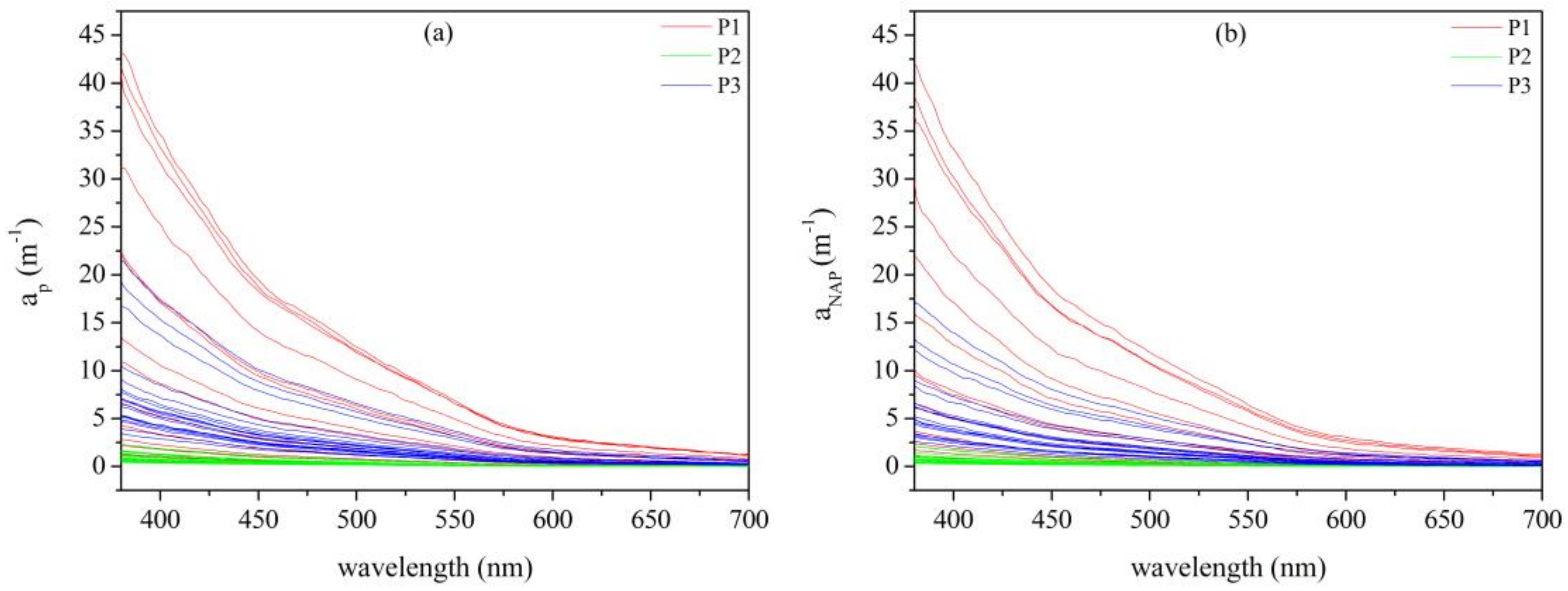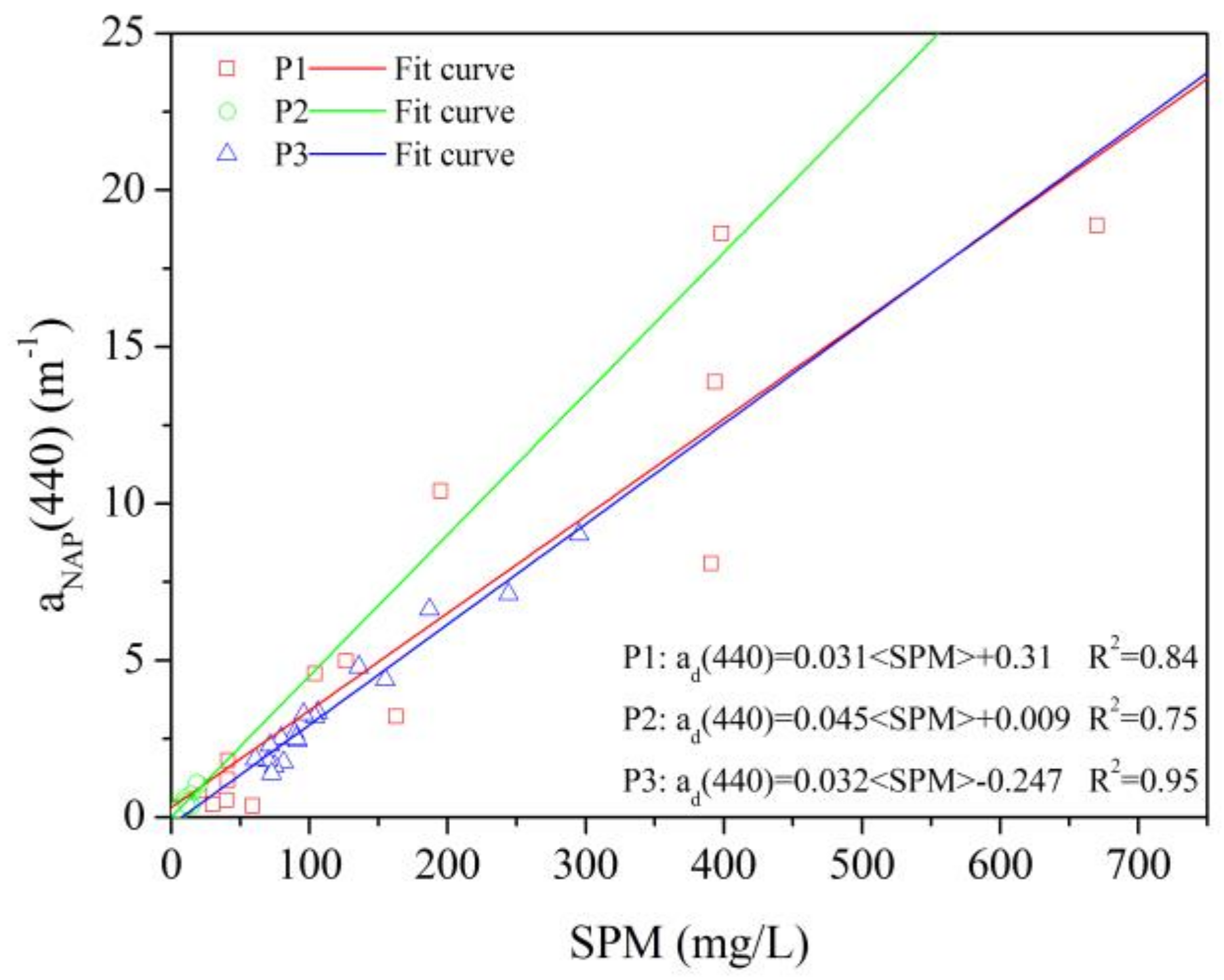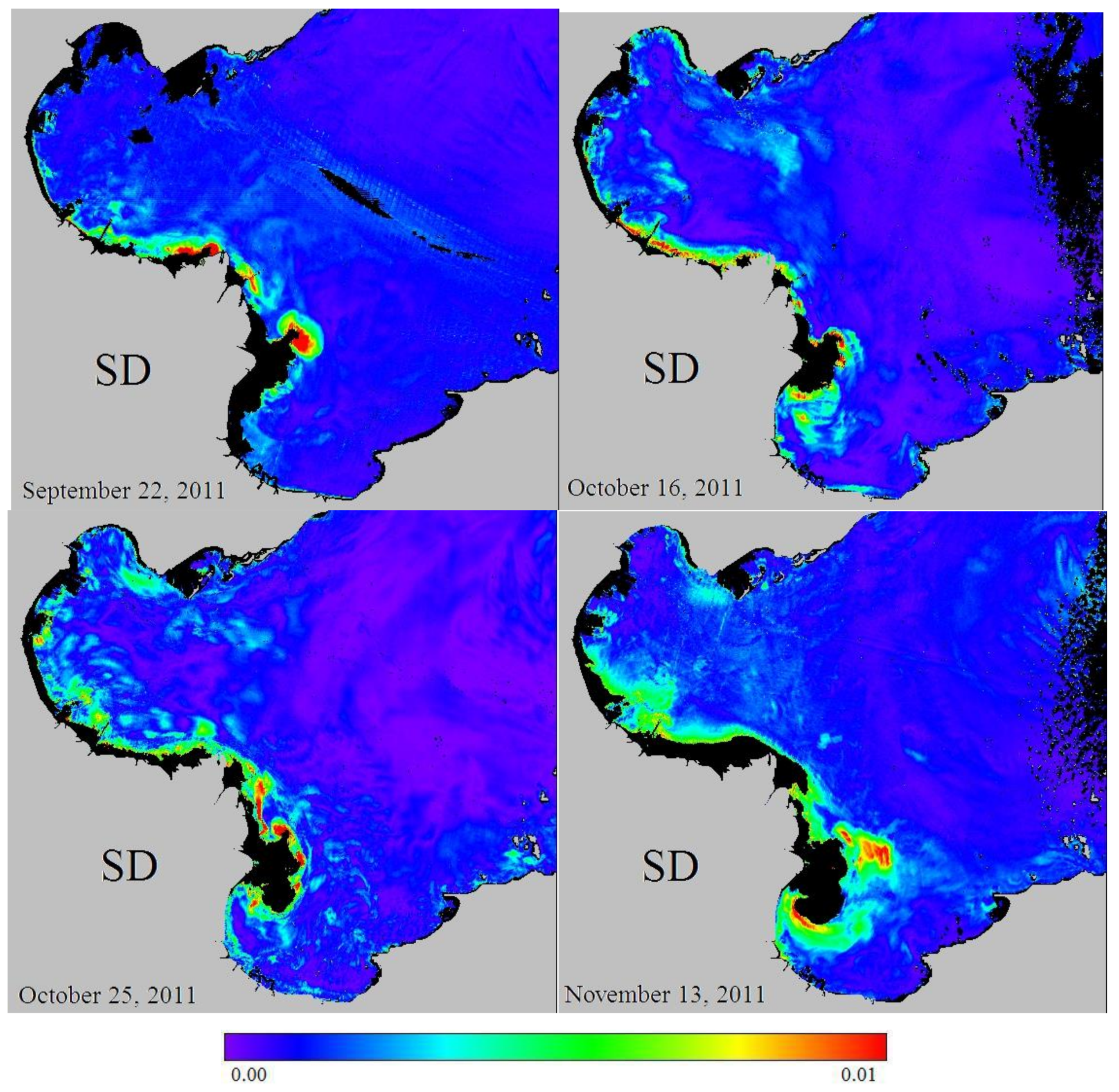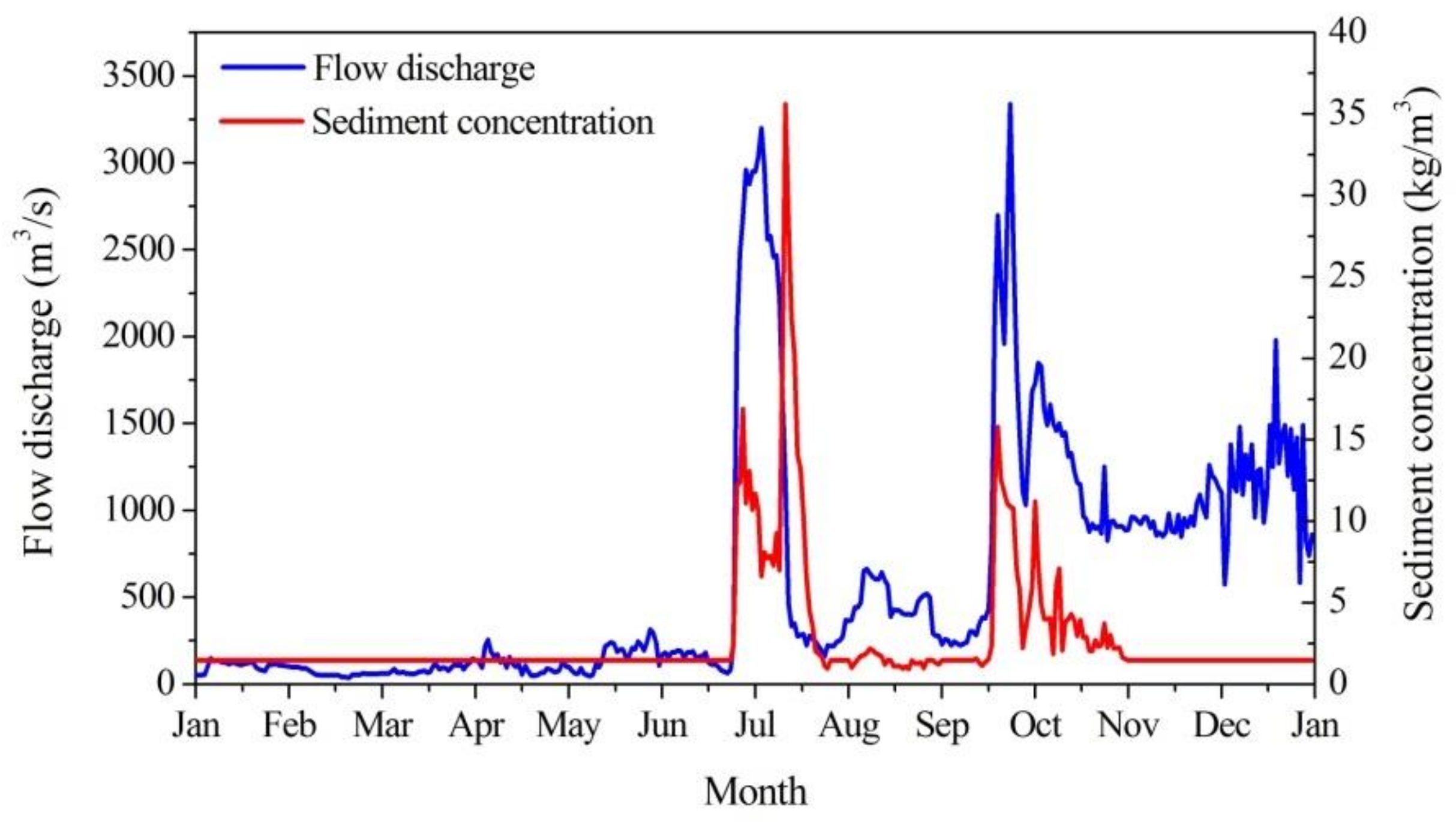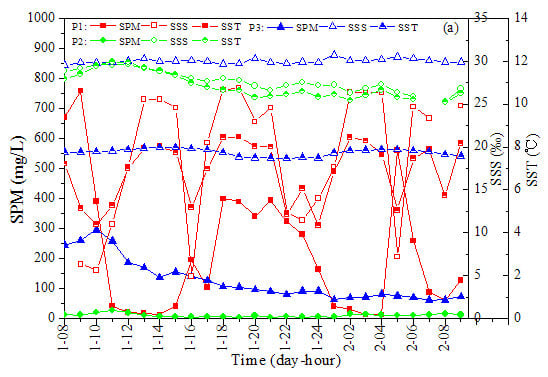Figure 1.
Location of in-situ stations in the Yellow River Estuary. Three continuous observations were conducted on 4 December 2011 (P1), 25 November 2011 (P2), and 11 December 2011 (P3).
Figure 1.
Location of in-situ stations in the Yellow River Estuary. Three continuous observations were conducted on 4 December 2011 (P1), 25 November 2011 (P2), and 11 December 2011 (P3).
Figure 2.
Hourly variations at Stations P1 (red squares, N = 26), P2 (green circles, N = 26) and P3 (blue triangles, N = 26) of: SPM, SSS, and SST (a); and Chl-a (b). The variation of SSS is consistent with that of SST which can be used as an indicator of the Yellow River discharge. The change tendency of SPM for Station P1 is opposite to that of SSS except for the time from 16 to 21, which is not obvious for Station P2 and P3.
Figure 2.
Hourly variations at Stations P1 (red squares, N = 26), P2 (green circles, N = 26) and P3 (blue triangles, N = 26) of: SPM, SSS, and SST (a); and Chl-a (b). The variation of SSS is consistent with that of SST which can be used as an indicator of the Yellow River discharge. The change tendency of SPM for Station P1 is opposite to that of SSS except for the time from 16 to 21, which is not obvious for Station P2 and P3.
Figure 3.
Time series of wind speed coming from NCEP around the Yellow River Estuary in: (a) November 2011; and (b) December 2011. (c) Time series of in-situ wind speed during the observation period at Stations P1 (open squares, N = 27), P2 (open circles, N = 27) and P3 (solid triangles, N = 27). The red lines indicate the dates when measurements were taken. Wind speed at Station P3 was higher than that at Stations P1 and P2, with the maximum wind speed up to 10.4 m/s. Strong winds occurred on 7 and 10 December before observation, with the highest wind speeds of approximately 14.2 m/s and 12.0 m/s, respectively.
Figure 3.
Time series of wind speed coming from NCEP around the Yellow River Estuary in: (a) November 2011; and (b) December 2011. (c) Time series of in-situ wind speed during the observation period at Stations P1 (open squares, N = 27), P2 (open circles, N = 27) and P3 (solid triangles, N = 27). The red lines indicate the dates when measurements were taken. Wind speed at Station P3 was higher than that at Stations P1 and P2, with the maximum wind speed up to 10.4 m/s. Strong winds occurred on 7 and 10 December before observation, with the highest wind speeds of approximately 14.2 m/s and 12.0 m/s, respectively.
Figure 4.
Spectral curve of CDOM absorption (a); and the CDOM absorption coefficient at 440 nm (b) at Stations P1 (red lines, N = 23), P2 (green lines, N = 25) and P3 (blue lines N = 24). The results show significant differences of diurnal variation of CDOM absorption at different stations.
Figure 4.
Spectral curve of CDOM absorption (a); and the CDOM absorption coefficient at 440 nm (b) at Stations P1 (red lines, N = 23), P2 (green lines, N = 25) and P3 (blue lines N = 24). The results show significant differences of diurnal variation of CDOM absorption at different stations.
Figure 5.
Relationships of: ag(440) vs. SSS (a); and ag(440) vs. SST (b), at Stations P1 (red squares, N = 21), P2 (green circles, N = 24) and P3 (blue triangles, N = 24). The solid line represents the linear regression with SSS and SST for ag(440). A general trend of decreasing CDOM with increasing SSS and SST was observed for Station P1 and Station P2, but not observed for Station P3.
Figure 5.
Relationships of: ag(440) vs. SSS (a); and ag(440) vs. SST (b), at Stations P1 (red squares, N = 21), P2 (green circles, N = 24) and P3 (blue triangles, N = 24). The solid line represents the linear regression with SSS and SST for ag(440). A general trend of decreasing CDOM with increasing SSS and SST was observed for Station P1 and Station P2, but not observed for Station P3.
Figure 6.
Power law relationship between ag(440) and Sg (a), and inverse linear relationship between the logarithm of ag(440) and Sg (b), at Stations P1 (red squares, N = 23), P2 (green circles, N = 25), and P3 (blue triangles, N = 24). The solid lines represent the fitted lines using the equations shown in the figure. The coefficients of determination R2 are shown in the figure. There is a strong negative relationship between ag(440) and Sg at Station P3, and a weak negative relationship at Station P2, but no observed relationship at Station P1.
Figure 6.
Power law relationship between ag(440) and Sg (a), and inverse linear relationship between the logarithm of ag(440) and Sg (b), at Stations P1 (red squares, N = 23), P2 (green circles, N = 25), and P3 (blue triangles, N = 24). The solid lines represent the fitted lines using the equations shown in the figure. The coefficients of determination R2 are shown in the figure. There is a strong negative relationship between ag(440) and Sg at Station P3, and a weak negative relationship at Station P2, but no observed relationship at Station P1.
Figure 7.
Spectral curves of: total particle absorption (a); and non-algal particle absorption (b), at Stations P1 (red lines, N = 16), P2 (green lines, N = 22) and P3 (blue lines, N = 18). Note that the magnitude of the spectral absorption coefficient for total particles was nearly similar to that for non-algal particles.
Figure 7.
Spectral curves of: total particle absorption (a); and non-algal particle absorption (b), at Stations P1 (red lines, N = 16), P2 (green lines, N = 22) and P3 (blue lines, N = 18). Note that the magnitude of the spectral absorption coefficient for total particles was nearly similar to that for non-algal particles.
Figure 8.
Variations of the non-algal to total particle absorption ratio (aNAP/ap) at different wavelengths as a function of the SPM concentration at Stations P1 (squares, N = 16), P2 (circles, N = 22) and P3 (triangles, N=18). Different colors represent different wavelengths. The contributions of aNAP(λ) to ap(λ) were more than 56.4% and 60.7% at all main wavelengths for Stations P1 and P3.
Figure 8.
Variations of the non-algal to total particle absorption ratio (aNAP/ap) at different wavelengths as a function of the SPM concentration at Stations P1 (squares, N = 16), P2 (circles, N = 22) and P3 (triangles, N=18). Different colors represent different wavelengths. The contributions of aNAP(λ) to ap(λ) were more than 56.4% and 60.7% at all main wavelengths for Stations P1 and P3.
Figure 9.
Hourly non-algal particles absorption coefficients at 440 nm at Stations P1 (red squares, N = 16), P2 (green circles, N = 22) and P3 (blue triangles, N=18). The diurnal variation of aNAP(440) showed significant difference for Stations P1, P2 and P3.
Figure 9.
Hourly non-algal particles absorption coefficients at 440 nm at Stations P1 (red squares, N = 16), P2 (green circles, N = 22) and P3 (blue triangles, N=18). The diurnal variation of aNAP(440) showed significant difference for Stations P1, P2 and P3.
Figure 10.
Relationship between aNAP(440) and SPM at Stations P1 (red squares, N=16), P2 (green circles, N = 22) and P3 (blue triangles, N = 18). The solid line represents the linear regression with SPM for aNAP(440), and the coefficients of determination R2 are shown in the figure. Note that there was a positive linear relationship between aNAP(440) and SPM for Stations P1, P2 and P3 with a correlation coefficient R2 greater than 0.75.
Figure 10.
Relationship between aNAP(440) and SPM at Stations P1 (red squares, N=16), P2 (green circles, N = 22) and P3 (blue triangles, N = 18). The solid line represents the linear regression with SPM for aNAP(440), and the coefficients of determination R2 are shown in the figure. Note that there was a positive linear relationship between aNAP(440) and SPM for Stations P1, P2 and P3 with a correlation coefficient R2 greater than 0.75.
Figure 11.
Ternary plots presenting the relative contribution of absorption by non-algal particles, phytoplankton pigments, and CDOM to total absorption by non-water constituents at different wavelengths at: (a) Station P1 (N = 15); (b) Station P2 (N = 23); and (c) Station P3 (N = 16). Different colors represent different wavelengths.
Figure 11.
Ternary plots presenting the relative contribution of absorption by non-algal particles, phytoplankton pigments, and CDOM to total absorption by non-water constituents at different wavelengths at: (a) Station P1 (N = 15); (b) Station P2 (N = 23); and (c) Station P3 (N = 16). Different colors represent different wavelengths.
Figure 12.
Remote sensing reflectance (Rrs(λ)) at different GOCI bands at Stations P1, P2 and P3 derived from GOCI images on 22 September (N = 8), 16 October (N = 8), 25 October (N = 7) and 13 November 2011 (N = 6). Different colors represent different stations. Note that the magnitude of diurnal variation of Rrs at Station P1 was larger than they were at Station P2 and P3 for all four days.
Figure 12.
Remote sensing reflectance (Rrs(λ)) at different GOCI bands at Stations P1, P2 and P3 derived from GOCI images on 22 September (N = 8), 16 October (N = 8), 25 October (N = 7) and 13 November 2011 (N = 6). Different colors represent different stations. Note that the magnitude of diurnal variation of Rrs at Station P1 was larger than they were at Station P2 and P3 for all four days.
Figure 13.
SD (standard deviation) maps of GOCI retrieved Rrs(680) in the Yellow River Estuary and its adjacent areas on 22 September, 16 October, 25 October and 13 November 2011. Note that the major regions of Rrs(680) diurnal variation were generally located in near-coastal waters and in the estuary of the Yellow River.
Figure 13.
SD (standard deviation) maps of GOCI retrieved Rrs(680) in the Yellow River Estuary and its adjacent areas on 22 September, 16 October, 25 October and 13 November 2011. Note that the major regions of Rrs(680) diurnal variation were generally located in near-coastal waters and in the estuary of the Yellow River.
Figure 14.
Time series of the Yellow River flow discharge and sediment concentration at Lijin hydrological gauging station in 2011. The flow discharge distribution had two high peaks from late June to early July and from late September to early October, respectively, which was mainly due to reservoir’s flood relief in the Yellow River upstream.
Figure 14.
Time series of the Yellow River flow discharge and sediment concentration at Lijin hydrological gauging station in 2011. The flow discharge distribution had two high peaks from late June to early July and from late September to early October, respectively, which was mainly due to reservoir’s flood relief in the Yellow River upstream.
Table 1.
Statistics of SPM and Chl-a concentration measured at Stations P1, P2 and P3. “Max.”, “Min.”, and “SD“ stand for maximum, minimum and standard deviation, respectively, and “N” is the number of samples.
Table 1.
Statistics of SPM and Chl-a concentration measured at Stations P1, P2 and P3. “Max.”, “Min.”, and “SD“ stand for maximum, minimum and standard deviation, respectively, and “N” is the number of samples.
| Stations | SPM (mg/L) | Chl-a (μg/L) |
|---|
| Max. | Min. | Mean | SD | N | Max. | Min. | Mean | SD | N |
|---|
| P1 | 758.69 | 11.92 | 220.00 | 216.44 | 26 | 1.34 | 0.24 | 0.78 | 0.27 | 26 |
| P2 | 26.45 | 3.67 | 9.95 | 5.68 | 26 | 1.11 | 0.38 | 0.62 | 0.20 | 26 |
| P3 | 295.22 | 60.87 | 125.09 | 69.67 | 26 | 0.77 | 0.41 | 0.53 | 0.12 | 26 |
Table 2.
CDOM absorption coefficients at 440 nm in the Yellow River Estuary at different stations. “Max.”, “Min.”, and “SD” stand for maximum, minimum, and standard deviation, respectively, and “N” is the number of samples.
Table 2.
CDOM absorption coefficients at 440 nm in the Yellow River Estuary at different stations. “Max.”, “Min.”, and “SD” stand for maximum, minimum, and standard deviation, respectively, and “N” is the number of samples.
| ag(440) | Max. (m−1) | Min. (m−1) | Mean (m−1) | SD (m−1) | N |
|---|
| P1 | 0.43 | 0.07 | 0.24 | 0.11 | 23 |
| P2 | 0.26 | 0.08 | 0.14 | 0.05 | 25 |
| P3 | 0.72 | 0.09 | 0.29 | 0.20 | 24 |
Table 3.
CDOM absorption spectral slopes (Sg) at Stations P1, P2 and P3. “Max.”, “Min.”, and “SD” stand for maximum, minimum, and standard deviation, respectively, and “N” is the number of samples.
Table 3.
CDOM absorption spectral slopes (Sg) at Stations P1, P2 and P3. “Max.”, “Min.”, and “SD” stand for maximum, minimum, and standard deviation, respectively, and “N” is the number of samples.
| Sg | Max. (nm−1) | Min. (nm−1) | Mean (nm−1) | SD (nm−1) | N |
|---|
| P1 | 0.021 | 0.012 | 0.017 | 0.002 | 23 |
| P2 | 0.020 | 0.012 | 0.016 | 0.002 | 25 |
| P3 | 0.018 | 0.008 | 0.013 | 0.003 | 24 |
Table 4.
Statistics of non-algal particles absorption coefficients at 440 nm at different stations. “Max.”, “Min.”, and “SD” stand for maximum, minimum, and standard deviation, respectively, and “N” is the number of samples.
Table 4.
Statistics of non-algal particles absorption coefficients at 440 nm at different stations. “Max.”, “Min.”, and “SD” stand for maximum, minimum, and standard deviation, respectively, and “N” is the number of samples.
| aNAP(440) | Max. (m−1) | Min. (m−1) | Mean (m−1) | SD (m−1) | N |
|---|
| P1 | 21.01 | 0.37 | 6.84 | 7.42 | 16 |
| P2 | 1.10 | 0.18 | 0.44 | 0.25 | 22 |
| P3 | 9.02 | 1.40 | 3.48 | 2.08 | 18 |
Table 5.
Non-algal particle absorption spectral slopes SNAP at Stations P1, P2 and P3. “Max.”, “Min.”, and “SD” stand for maximum, minimum, and standard deviation, respectively, and “N” is the number of samples.
Table 5.
Non-algal particle absorption spectral slopes SNAP at Stations P1, P2 and P3. “Max.”, “Min.”, and “SD” stand for maximum, minimum, and standard deviation, respectively, and “N” is the number of samples.
| Derived SNAP | Max | Min | Mean | SD | N |
|---|
| P1 | 0.0120 | 0.0104 | 0.0113 | 0.00042 | 16 |
| P2 | 0.0115 | 0.0100 | 0.0108 | 0.00035 | 22 |
| P3 | 0.0108 | 0.0097 | 0.0103 | 0.00029 | 18 |
Table 6.
Rrs(680) derived from GOCI images on 22 September, 16 October, 25 October and 13 November 2011. “Max.”, “Min.”, and “SD” stand for maximum, minimum, and standard deviation, respectively, and “N” is the number of samples.
Table 6.
Rrs(680) derived from GOCI images on 22 September, 16 October, 25 October and 13 November 2011. “Max.”, “Min.”, and “SD” stand for maximum, minimum, and standard deviation, respectively, and “N” is the number of samples.
| Rrs(680) (sr−1) | 22 September 2011 | 16 October 2011 |
|---|
| Max. | Min. | Mean | SD | N | Max. | Min. | Mean | SD | N |
|---|
| P1 | 0.0366 | 0.0140 | 0.0236 | 0.0092 | 8 | 0.0404 | 0.0137 | 0.02340 | 0.0091 | 8 |
| P2 | 0.0105 | 0.0053 | 0.0079 | 0.0019 | 8 | 0.0060 | 0.0041 | 0.0054 | 0.0007 | 8 |
| P3 | 0.0093 | 0.0035 | 0.0052 | 0.0017 | 8 | 0.0048 | 0.0031 | 0.0039 | 0.0006 | 8 |
| | 25 October 2011 | 13 November 2011 |
| P1 | 0.0421 | 0.0203 | 0.0280 | 0.0080 | 7 | 0.0383 | 0.0251 | 0.0341 | 0.0054 | 6 |
| P2 | 0.0250 | 0.0143 | 0.0201 | 0.0042 | 7 | 0.0207 | 0.0152 | 0.0189 | 0.0021 | 6 |
| P3 | 0.0227 | 0.0175 | 0.0201 | 0.0021 | 7 | 0.0160 | 0.0124 | 0.0146 | 0.0015 | 6 |

